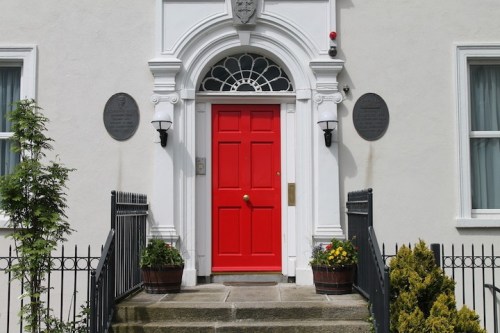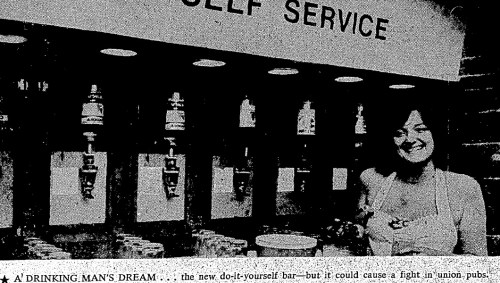It has come to light in the last week that deceased, convicted paedophile and former pirate radio personality Eamon Cooke (1936 – 2016) may have been involved in the disappearance and death of 13-year-old schoolboy Philip Cairns who went missing from Rathfarnham in October 1986.
After reading an excellent Broadsheet.ie post, I thought it would be useful to elaborate on Cooke’s brushes with the law in the 1950s, 1960s and 1980s. It is likely that he had some connections with the republican movement during this time period.
Eamonn Cooke was born on 4th November 1936 in Derravaragh Road, Kimmage. The family later settled across the river at St. Theresa’s Place, Glasnevin. In an interview given to Peter Mulryan for his book ‘Radio Radio: The Story of Independent, Local, Community and Pirate Radio in Ireland‘ (1988), Cooke described his parents as “Ultra Republican”.
In ‘Playing in the Dark’ (2011) by journalist Rosie Dunn and Cooke-victim Siobhan Kennedy-McGuinnes, they cited an article (pp. 253-54) that Cooke wrote in which he claimed that his mother was a member of Cumann na mBan during the Civil War and that he was in an “active service unit” during the 1950s. It also mentioned the following two incidents that occurred in 1952 and 1957.
In 1952, the O’Connell Monument in Glasnevin Cemetery was damaged by a homemade bomb. Three boys were quickly arrested, one of whom was brought before the courts. Aged 15, this ringleader was sentenced to 12 months probation. As Donal related in a 2012 CHTM! article :
In a statement to police the boy said that “about two years ago I learned from other boys at school how to make explosions with potassium chlorate, charcoal and sulfur.” He was alleged to have told Gardaí he had set off some small trial bombs in the area, and had “purchased the ingredients for the bomb in small quantities in chemists’ shops for only a few pence.” On the afternoon before attempting his bombing at O’Connell’s tomb, the young 15-year-old used an old bicycle frame to pack in the required ingredients.
At 8.30pm on June 6th, the youngster climbed the O’Connell Tower, planting his crude explosion on the top storey with a lighted candle. When asked why he had done it, the lad remarked that “because it was so high”, he expected “a lot of noise and a big flash.”
A number of leads point to Eamon Cooke being the unnamed 15-year-old charged.
The first comes from the late great Shane MacThomais, Glasnevin Cemetery historian, who commented on Donal’s 2012 article:
did you know that the youth in question went on to become a famous Dublin Dj of the 1970s and a convicted rapist in 2007. He paid the cemetery 30 shillings for the glass broke in the tower.”
Cooke was born in 1936 so would have been 15/16 in 1952 and he lived just two minutes walk from the Cemetery. It’s also mentioned in a recent HotPress article (though they say 1960s) and the Broadsheet.ie piece (though they incorrectly say 1950).
In 1957, Eamonn Cooke (21) or Edward Joseph Patrick Cooke, a clerk, of 18 St. Theresa’s Place, Glasnevin, was sentenced to five years imprisonment at Wicklow Circuit Court. On the night of 18th February, he had shot six times at Gardai at Hollybrook Garage near Wingfield, Bray, Co. Wicklow.
Escaping the scene but later arrested at his home, he was charged with:
1) Attempted murder of four members of the Garda Siochana
2) Having a revolver in his possession with intent to endanger life or cause serious injury to property
3) Breaking and entering the lock-up garage of Patrick Farrell
4) Having in his possession a revolver without a firearm certificate
5) Causing malicious damage
Cooke replied to the first charge : “At the time I fired the shots, I did not know that they were police and I did not fire directly at the police”. To the second charge, he said : “I had no intention to endanger life”. He pleaded guilty to the third and fourth charges and in reply to the fifth : “I admit some damages”.
The prosecution later withdrew the first charge changing it to “shooting at four Gardai with intent to to resist or prevent lawful apprehension”.
In a statement, Cooke said that he noticed the garage after being in the Dublin Mountains with friends shooting and decided he would raid it for petrol. He broke the locks on two petrol pumps with an iron bar at the garage but the pumps were empty. Cooke stated that that he bought the gun six months ago to shoot at birds.
For the defence, Dr. Mary P. Mulvany, said the accused “suffered from meningitis, was of superior intelligence, was impulsive, and fond of approbation, and though not suffering from mental disease, was not completely stable and should receive prolonged psychological treatment.”

Eamonn Cooke newspaper report. (Irish Times, 19 Feb 1957)
In 1965, Sean Colley (20), a plumber, of 80 Decies Road, Ballyfermot was sentenced to six months imprisonment after being convicted of having a Lee Enfield rifle and eight rounds of ammunition on September 8th of that year. He was also charged for on that day assaulting Eamon Cooke, of 3 Sarsfield Road, Balyfemrot by pointing the rifle at him after an argument. When charged, Colley replied : “When I pointed the gun … it was not loaded. The magazine was taken out and in my pocket. I have no licence for the rifle”.
Colley stated in evidence that he “was not a member of an illegal organisation” and did not know if the gun was “the property of the I.R.A.”. He said the gun came into his possession after a written note was put in his door asking him to call to a cafe in Sandymount to collect the gun which he did. Cooke and Colley fired it at least once in the Dublin Mountains.
(A man by the name of Sean Colley, aged 30, was one of three Irishmen in Lancashire sentenced in 1973 to up to four years imprisonment for conspiring to blow up public buildings. The Sean Colley from Ballyfermot would have been 28 in 1973).

Eamonn Cooke newspaper report. (Irish Press, 05 Nov 1965)
In 1969, Cooke was given a brand new TV set by Hazlett’s Ltd. in exchange for his outdated 1949 model.

The Sunday Independent (21 December 1969)
In 1973, a letter to the Sunday Independent accused Cooke of being a police informer. It was published with a picture of Cooke.

Eamonn Cooke newspaper report (Sunday Independent, 25 March 1973).
It was revealed as far back as 1988 in Mulryan’s book (1988) that Cooke:
before getting involved in radio, Cooke had risen to fame in the Sunday World for his vigilante activities. Eamonn would tune into the police frequencies and when an emergency or disturbance was reported, he would jump into his Jaguar and speed up off the back streets to help the police apprehend the criminals.
Bodger recently summed in up in his excellent piece on Broadsheet.ie that Cooke in the 1960s and 1970s would involve himself:
in live Garda operations and patrols in the Kilmainham area of the city on a nightly basis, installing a CB radio and a blue flashing light in his Jaguar car and uses the call-sign “Alpha 7” to report the movements of stolen vehicles in Dublin ‘A’ District, pursuing and ramming them himself.
In April 1978, staff at Radio Dublin ‘mutiny’ after Cooke’s sexual abuse of a local girl is discovered. The Irish Press report that it was due to “allegations” made about his “personal conduct”. A week later, they go further and describe that the “reported allegations” against Cooke are related to “connected with charges of child molesting”.

Eamon Cooke newspaper report. (Irish Press, 10 April 1978). via Broadsheet.ie
Cooke took to the airwaves to protest innocence.

A 1978 issue of Magill magazine described him as the ““Godfather” of pirate radio in Dublin … an innocuous, quietly spoken IRA man.”

Eamonn Cooke (Sunday Independent, 05 February 1978)
In the late 1970s, Jimmy Saville visited Cooke at Radio Dublin a number of times.

The Irish Press (18 January 1978)
In September 1980, Sunshine Radio began test transmissions from Portrmarnock. Not long after their large aerial mast in the Sands Hotel was brought down by an explosive device. Robbie Robinson, who was involved in the station, blamed the attack on one of the “most immature Dublin pirate stations” in a recent interview. Robinson disclosed that when the mast was being constructed a “strange character with binoculars” was spotted “lying in long grass in a field nearby.”
A Dublin-based historian and political activist of long standing has told me that at the time everybody believed that Cooke was the perpetrator.
In November 1984, Cooke organised the petrol-bombing of the home of John Paul O’Toole on South Circular Road. O’Toole had worked for Cooke at Radio Dublin but had been sacked. He was “seen” with Cooke’s former girlfriend who was the mother of his three-year-old son. Cooke wanted revenge and so approached a number of men to carry out the attack.
In 1986, four men were charged in connection with the firebomb attack. They were Gerard McMullan (40), of Ballyfermot Drive; Eugene Geoghegan (40) of Donard Avenue, Blackhorse Avenue; Alan Callopy (33), Ballyfermot Drive and George Sneddon (33) of Glentow Road, Whitehall.
Cooke (49), of 58 Inchicore Road, pleaded guilty to conspiring to assault O’Toole and was given a four-year suspended sentence and . It was stated at the time that Cooke had five previous convictions with the last one dating back to 1957.

Eamon Cooke newspaper report. (Irish Press, 04 Nov 1986).
In 2003, Cooke was convicted for attempted rape, attempted unlawful carnal knowledge and sexual and indecent assault of four girls but the conviction was later quashed on a legal technicality. He was released in May 2006 but was brought again to court and convicted, in 2007, on 42 counts of sexual abuse of children. In early June 2016, Cooke died at at the age of 79 in a Dublin hospice to which he had been transferred from prison
Sources:
Newspaper articles – Irish Independent (19 Feb 1957), Irish Press (13 April 1957) Irish Examiner (13 April 1957), Irish Independent (20 Sep 1955), Irish Press (05 Nov 1965), Irish Times (22 Oct 1986), Irish Times (23 Oct 1986)
Books – Peter Mulryan, ‘Radio Radio: The Story of Independent, Local, Community and Pirate Radio in Ireland‘ (1988), Rosie Dunn and Siobhan Kennedy-McGuinness, ‘Playing in the Dark‘ (2011)

































 Click on the book for more.
Click on the book for more. Click on the book for more.
Click on the book for more.